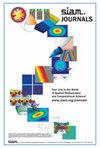利用差分吸收激光雷达成像大气弥散过程
IF 2.3
3区 数学
Q3 COMPUTER SCIENCE, ARTIFICIAL INTELLIGENCE
引用次数: 0
摘要
SIAM 影像科学期刊》第 17 卷第 3 期第 1467-1510 页,2024 年 9 月。 摘要:我们考虑了基于时间分辨后向散射差分吸收激光雷达(DIAL)测量的大气弥散参数拟合反问题。光基遥感模式的明显优势在于其扩展的空间范围,这使其对严格的局部扰动/建模误差或羽流源的距离不那么敏感。与其他最先进的 DIAL 方法相比,我们没有采用单一的散射假设,而是提出了一种新型模式,包括从更宽/多个视场收集多散射光子,并认为这种数据与时间相关辐射传递模型搭配,有利于重建某些图像特征。由此产生的逆问题可通过半参数方法来解决,在这种方法中,图像被简化为少量与色散相关的参数和高维但便于计算的滋扰分量。这不仅让我们有效地避免了高维逆问题,同时还提供了一种自然的正则化机制,以及与频散模型直接相关的参数。这些参数可以与有意义的物理单位相关联,而空间浓度剖面则可以通过对扩散过程的正向评估来获得。本文章由计算机程序翻译,如有差异,请以英文原文为准。
Imaging of Atmospheric Dispersion Processes with Differential Absorption Lidar
SIAM Journal on Imaging Sciences, Volume 17, Issue 3, Page 1467-1510, September 2024.
Abstract.We consider the inverse problem of fitting atmospheric dispersion parameters based on time-resolved back-scattered differential absorption Lidar (DIAL) measurements. The obvious advantage of light-based remote sensing modalities is their extended spatial range which makes them less sensitive to strictly local perturbations/modelling errors or the distance to the plume source. In contrast to other state-of-the-art DIAL methods, we do not make a single scattering assumption but rather propose a new type modality which includes the collection of multiply scattered photons from wider/multiple fields-of-view and argue that this data, paired with a time dependent radiative transfer model, is beneficial for the reconstruction of certain image features. The resulting inverse problem is solved by means of a semiparametric approach in which the image is reduced to a small number of dispersion related parameters and high-dimensional but computationally convenient nuisance component. This not only allows us to effectively avoid a high-dimensional inverse problem but simultaneously provides a natural regularization mechanism along with parameters which are directly related to the dispersion model. These can be associated with meaningful physical units while spatial concentration profiles can be obtained by means of forward evaluation of the dispersion process.
Abstract.We consider the inverse problem of fitting atmospheric dispersion parameters based on time-resolved back-scattered differential absorption Lidar (DIAL) measurements. The obvious advantage of light-based remote sensing modalities is their extended spatial range which makes them less sensitive to strictly local perturbations/modelling errors or the distance to the plume source. In contrast to other state-of-the-art DIAL methods, we do not make a single scattering assumption but rather propose a new type modality which includes the collection of multiply scattered photons from wider/multiple fields-of-view and argue that this data, paired with a time dependent radiative transfer model, is beneficial for the reconstruction of certain image features. The resulting inverse problem is solved by means of a semiparametric approach in which the image is reduced to a small number of dispersion related parameters and high-dimensional but computationally convenient nuisance component. This not only allows us to effectively avoid a high-dimensional inverse problem but simultaneously provides a natural regularization mechanism along with parameters which are directly related to the dispersion model. These can be associated with meaningful physical units while spatial concentration profiles can be obtained by means of forward evaluation of the dispersion process.
求助全文
通过发布文献求助,成功后即可免费获取论文全文。
去求助
来源期刊

SIAM Journal on Imaging Sciences
COMPUTER SCIENCE, ARTIFICIAL INTELLIGENCE-COMPUTER SCIENCE, SOFTWARE ENGINEERING
CiteScore
3.80
自引率
4.80%
发文量
58
审稿时长
>12 weeks
期刊介绍:
SIAM Journal on Imaging Sciences (SIIMS) covers all areas of imaging sciences, broadly interpreted. It includes image formation, image processing, image analysis, image interpretation and understanding, imaging-related machine learning, and inverse problems in imaging; leading to applications to diverse areas in science, medicine, engineering, and other fields. The journal’s scope is meant to be broad enough to include areas now organized under the terms image processing, image analysis, computer graphics, computer vision, visual machine learning, and visualization. Formal approaches, at the level of mathematics and/or computations, as well as state-of-the-art practical results, are expected from manuscripts published in SIIMS. SIIMS is mathematically and computationally based, and offers a unique forum to highlight the commonality of methodology, models, and algorithms among diverse application areas of imaging sciences. SIIMS provides a broad authoritative source for fundamental results in imaging sciences, with a unique combination of mathematics and applications.
SIIMS covers a broad range of areas, including but not limited to image formation, image processing, image analysis, computer graphics, computer vision, visualization, image understanding, pattern analysis, machine intelligence, remote sensing, geoscience, signal processing, medical and biomedical imaging, and seismic imaging. The fundamental mathematical theories addressing imaging problems covered by SIIMS include, but are not limited to, harmonic analysis, partial differential equations, differential geometry, numerical analysis, information theory, learning, optimization, statistics, and probability. Research papers that innovate both in the fundamentals and in the applications are especially welcome. SIIMS focuses on conceptually new ideas, methods, and fundamentals as applied to all aspects of imaging sciences.
 求助内容:
求助内容: 应助结果提醒方式:
应助结果提醒方式:


